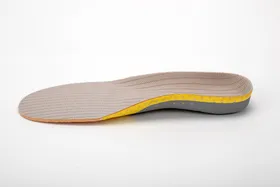Most Common Causes of Heel Pain After Running
Updated December 17, 2024

Heel pain is a relatively common injury among athletes, especially runners. The pain often starts subliminally, which can progressively worsen if left unmanaged. Without treatment, heel pain can make walking difficult and make carrying out your regular activities of daily living difficult.
Unfortunately, there is no blanket treatment for heel pain. Rather, your approach depends on the specific cause. In this guide, we’ll carefully consider what heel pain after running looks like, what causes it, and how to prevent it.
Heel Pain After Running: What Is It?
When heel pain occurs, expect to experience some tenderness or pain at the back of the heel, at the bottom of the heel, or within the heel bone. The location of the pain is important, as it can indicate the cause of the pain.
Plantar fasciitis, for example, is the most common type of heel pain that occurs under the heel. The pain is characterized by mild pain when running or exercising, becoming more severe after exercise or when resting. In addition, the pain may occur intermittently or regularly and makes it difficult to lift your toes off the floor.
Most Common Causes of Heel Pain After Running
Any number of reasons could result in heel pain after running. The most common causes include:
- Plantar fasciitis: The plantar fascia is the thick band of tissue that runs along the bottom of the foot. Plantar fasciitis occurs in as much as 8% of runners due to repetitive stress, overuse, and a weakening of the collagen fibers surrounding the fascia. Pain due to plantar fasciitis has a gradual onset. However, there can be sudden onset of pain when there is microtrauma or tearing of the plantar fascia.
- Structural problems: Both high arches and fallen arches put a strain on the plantar fascia. As a result, you may experience pain after running if you suffer from either of these arch problems.
- Obesity: Obese individuals tend to place excess weight on their ankle joint and foot, causing pain in those regions.
Other Conditions That Can Cause Heel Pain After Running
The conditions listed above may be the most common causes of heel pain after running, however, they are not the only sources of pain. Many other conditions can cause heel pain, albeit less frequently. They include;
- Calcaneal apophysitis (Sever’s disease): Sever’s disease is a common cause of heel pain in active children who run and jump a lot. The increase in activity irritates the growth plate located at the back of the heel, which, in turn, causes heel pain.
- Achilles tendonitis: As the name implies, Achilles tendonitis is the inflammation of the Achilles tendon, or the fibrous cord that connects the calf muscles to the heel bone. Tight calf muscles, obesity, and poor gait mechanics are the major causes. Apart from pain, you may also notice redness and swelling around the heel bone.
- Heel spurs: A heel spur is a bony outgrowth around the heel bone. They often go undetected at first, but continue to grow as more and more calcium deposits compound in the area. While it doesn’t directly cause pain, it causes inflammation of the surrounding tissues, leading to pain. The symptoms of heel spurs and plantar fasciitis are similar, so they are frequently misdiagnosed.
- Bursitis: This condition refers to the inflammation of the bursae, which are fluid-filled sacs found between muscles, tendons, and bones. Bursae are responsible for reducing friction and allowing smooth movement over bony surfaces. However, excessive movement and strain of the bursae lead to inflammation, which often causes sharp or shooting pain and swelling or redness.
- Arthritis: Osteoarthritis or rheumatoid arthritis in the ankle joint will lead to inflammation in and around the heel bone, causing pain.
- Nerve compression: Compression of the nerves in the foot can cause sharp, radiating pain at the heels and make the feet feel heavy to lift.
Can You Prevent Heel Pain After Running?
Heel pain after running is preventable using a combination of methods. Ensuring you run with proper footwear for your foot type and gait while avoiding hard surfaces is a good way to start. Analyzing your gait can help you understand exactly how you run, so you can make necessary adjustments to your technique.
Beyond this, avoid sudden increases in your mileage, and aim to keep increases below 10% weekly. Strengthening exercises for heel pain and stretching your plantar fascia and Achilles tendon are also recommended.
If, after all these, you still develop heel pain, you can easily manage it using conservative means. These include the use of ice, NSAIDs, massage, orthotic insoles, custom orthotics, and vitamins,
Avoid running with heel pain as it can prolong the healing time. However, if the pain remains following weeks of conservative management, it is time to see a doctor.
Your doctor will take a detailed history of your heel pain and examine your foot objectively. The doctor will then prescribe a suitable treatment approach. As a last resort, surgery may be necessary if the pain problem persists.








